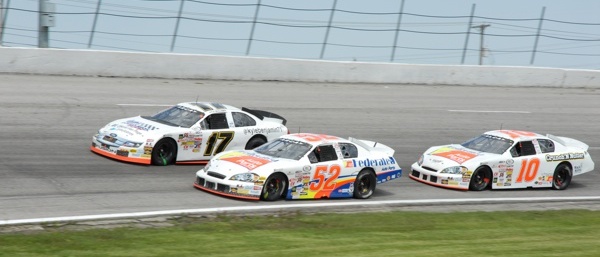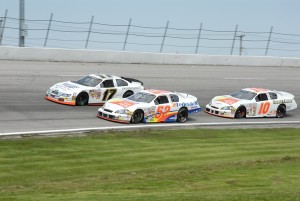
Those oval track fans not familiar with the Automobile Racing Club of America (ARCA) are really missing some great racing – and on a lot of different levels. From the on-track level, where else can you see full bodied, NASCAR-style, stock cars racing on everything from Daytona to local Bull Ring, short tracks with literally every kind of track in between.
There are Intermediate NASCAR tracks, road courses and one style of track not seen racing NASCAR stock cars; dirt!
To be exact, these are former NASCAR Sprint Cup cars with virtually the exact same rules. And that brings another popular element of ARCA racing; it’s the stepping stone to NASCAR’s Sprint Cup Series. But it’s not only drivers that are learning to move up to Cup level. ARCA is its own distinctive series that also offers a training ground for mechanics, crew chiefs and even owners and media people. And, they do it with NASCAR equipment and procedures so when moving up, there is no ‘unlearning’ to go through.
‘Yesterday’s’ Racer
ARCA uses older style NASCAR Cup cars. Specifically, they are the ones used just before the advent of NASCAR’s Car Of Tomorrow (COT) in 2007.
This means teams running ARCA can do so with a safe, well-built race car without paying top dollar. When the COT changeover first occurred, the older cars in ‘roller’ stage (minus engine and trans) could be had for as little as $2,000.
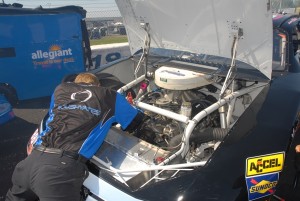
After all, the new COT cars pretty much ‘orphaned’ all the previous cars. The surprising fact is that once the cars from that era were accounted for, the demand continued and folks had to start building ‘new’ old cars. When they started doing that, they incorporated as many of the newer safety modifications as they could.
But it’s specifically the engines we want to look at here. The big picture is the engines used in the ARCA Racing Series Presented by Menards fall into the same category as modern day NASCAR Sprint Cup engines.
They are mostly the same 358 cubic inch limit engines used in Cup only with the older carb instead of the EFI used in Cup today.
ARCA Supercars use the 830 CFM Holley carbs the Cup cars used to run before they went to EFI. We say mostly because the other big difference is these engines are not allowed to run the RPM seen in Cup action. ARCA mandates the use of spec electronics ignition with built in rev limiter.
Ignition Systems
To provide a level playing field for ARCA racers, the specially made ACCEL CD Pro, Endurance Racing Ignition, a twin ignition/coil system, is used with units being assigned by ARCA for races and collected afterwards.
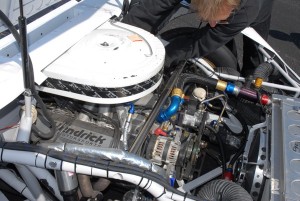
They’ve been using this system since 2005, with close to two million miles of racing and no problems. One big function of this system is the rev limiter, which caps every engine at 8,800 RPM.
This effectively excludes some of the more advanced Cup engines, which are known to run at 10,000 RPM and push HP ratings up towards 1,000. The thinking is clear as there is a big presence of Cup teams using ARCA as a farm league to develop drivers. With the other teams in ARCA not having that advantage, the ignition/rev limiter keeps things on a broader playing field.
Building Connections
Another NASCAR connection is where many of these engines come from. A quick look reveals the logos on the valve covers of Roush Yates, Hendricks, RCR and even the one place most of the Toyota engines come from, TRD.
Roush Yates, for one example, has builders dedicated to just these engines and sends tuners to the track with them.
It’s good business as they already have the parts in house while ARCA and NASCAR teams provide the market.
Sometimes, the teams are owned by the bigger Cup teams while many are ARCA owners that provide the programs for the Cup teams
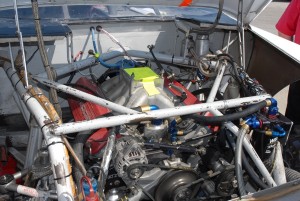
and get access to cars, parts and technology to be competitive.
Another major Cup team, Joe Gibbs Racing, uses engines built by TRD for its Cup teams, but builds its own engines for the ARCA teams they are affiliated with and lease to. And remember those Dodges used in NASCAR? Well, they found a new home in ARCA and are still racing.
New to the Race
But ARCA’s unique engine rules will start to change in 2015. They recently announced an addition to its engine program where, along with the aforementioned engines, an entirely new engine will see duty on ARCA tracks. The ARCA Racing Series presented by Menards will use the new, ARCA Ilmor 396 engine, a purpose-built powerplant developed and assembled by legendary engine builder Ilmor Engineering.
The major design targets are reduced RPM (read that speeds), reduced costs and has a number of major players already involved.
Ron Drager is the president of ARCA and said it was a, “…conclusion to a long and extensive search to find the right strategic partner to help us address the challenges of rising costs in our series.” He went on to say, “It is my pleasure to announce that Ilmor Engineering has partnered with us to develop the ARCA Ilmor 396 engine technology, which provides a long term, stable platform delivering an economical and competitive option to our existing engine configurations.”
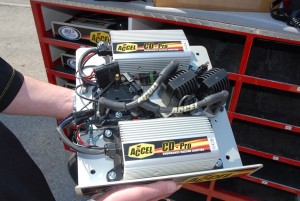
The new ARCA Ilmor 396 will deliver 700 horsepower and 500 ft. lbs. of torque, with targeted durability and performance standards. It will be fuel injected, with Holley EFI technology regulating the Electronic Control Unit and the fuel injection system. “We’re proud to add ARCA and Ilmor to the growing list of sanctioning bodies, OEMs and professional-level engine builders using Holley EFI electronics and hardware on their race engines,” said Trevor Wiggins, Holley VP of Sales. “Our EFI engineering and tech groups are gearing up to assure this transition is seamless.”
“Holley carburetors have powered ARCA racers over two million miles in the last two decades alone, so it is a natural transition for Holley fuel injection to deliver the fuel on the ARCA Ilmor 396,” added Drager.
Paul Ray, President of Ilmor Engineering, said, “We’ve partnered with ARCA to construct a durable, reliable engine capable of running 1,500 miles between rebuilds. The teams will be able to use the same ARCA Ilmor 396 at short tracks or a superspeedway, a road course or the mile dirt tracks. We have begun to conduct extensive testing and our plan calls for the first engines to be available for purchase by the teams by early December,” Ray concluded.
The similarity between ARCA and NASCAR is easy to see. In fact, not long after ARCA made its initial announcement about the ARCA Ilmor 396, NASCAR made its new rules announcement for the engines used in Sprint Cup racing next year. They, too were concerned with reducing speeds at all the tracks.

One example is where NASCAR teams recently crested 200 MPH at Michigan International Speedway with the top 20 drivers in qualifying for one race hitting 200 or better. Prior to this, an official 200 MPH lap speed had not been seen in NASCAR in over 25 years.
And as many ARCA races take place in conjunction with NASCAR races and tracks, the moves are seen as another alignment of the equipment between the two organizations.
ARCA teams will have the option of utilizing the new ARCA Ilmor 396 beginning in 2015, or continuing to use the open motor rules package currently in place. “We have identified and are addressing the financial challenges of racing competitively faced by many ARCA teams,” said Drager. “Our responsibility as the sanctioning body is to manage the bigger picture business model for all our stakeholders. The ARCA Ilmor 396 is the best engine option we can introduce for the long-term health of our series,” said Drager.
Economic Factors
One of the challenges Drager spoke of is the cost of using a state of the art NASCAR Cup engine.
Teams have already been noted as spending close to $400,000 to lease Cup motors for a season. ARCA has really done its homework on this engine program with many other benefits to new users.
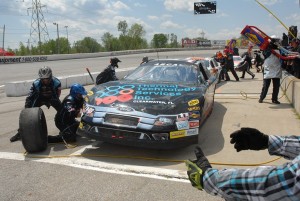
One ARCA official told us it was a matter of ARCA changing with the world economy.
The new Ilmor motors will be purchase-only and should have a price tag of about $35,000 plus tax and shipping.
Another approximate $5,000 will be needed for incidentals such as headers, plumbing, wiring harness and the Holley Electronic Control Unit with built-in rev limiter. RPM will be reduced to 7,500.
So, with this new engine, ARCA has evolved much like NASCAR with both EFI and reduced rear wheel horsepower for the future.
The new Ilmor is based on LSX architecture and will be a sealed and tamper proof engine with suggested rebuilds at 1,500 miles.
The rules include limiting rebuilding the engines to not before 80% of that 1,500 miles or 1,200 miles. The cost for rebuilding is estimated at $10,000 – $15,000.
The new engines will also be used for ARCA’s two restrictor plate races at Daytona and Talladega.
Right out of the box, they were deemed fast enough to require the plates. Ilmor’s facility in Michigan is close to the home base of ARCA just outside of Toledo, OH.
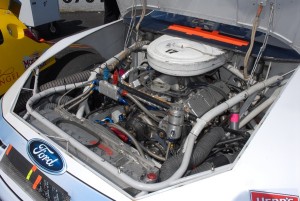
As the transition into these engines progresses, it’s clear they are two different motors. Keeping them competitive, yet not allowing one to have any advantage is ARCA’s tough job and they are focusing there as we write this.
They are currently working on a few methods for averaging speeds and motor characteristics in the name of competition and to make this transition as smooth as possible.
The use of tapered spacers is already in play at Intermediate tracks and is one such solution. Others include controlled RPM and different restrictor plates for the Daytona and Talladega races. All are being considered.
One area where they really have to get it right from the beginning are the short tracks ARCA is known for. Those smaller, local bull rings are a big place for any ARCA team looking to assert themselves into a championship bid.
And even with a bigger, heavier car than is normally seen on a typical half mile paved track, the classic RPM/Horsepower matrix still rules.
With the proliferation of information on race engine performance and how it plays out with any chassis available today, it shouldn’t take them too long. The initial response from ARCA teams on the new motor is very favorable with many wanting in on the program.
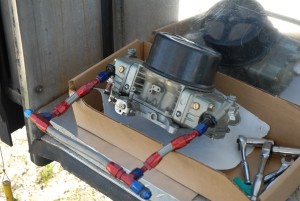 Racing is a constant hotbed of technology. ARCA’s use of this new engine should keep the ‘new’ part of racing from trading fenders with the ‘cost’ part of racing.
Racing is a constant hotbed of technology. ARCA’s use of this new engine should keep the ‘new’ part of racing from trading fenders with the ‘cost’ part of racing.


